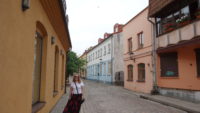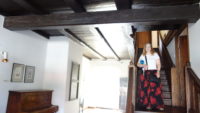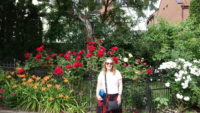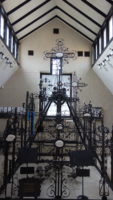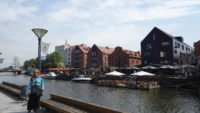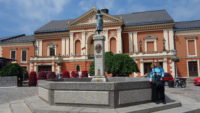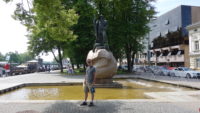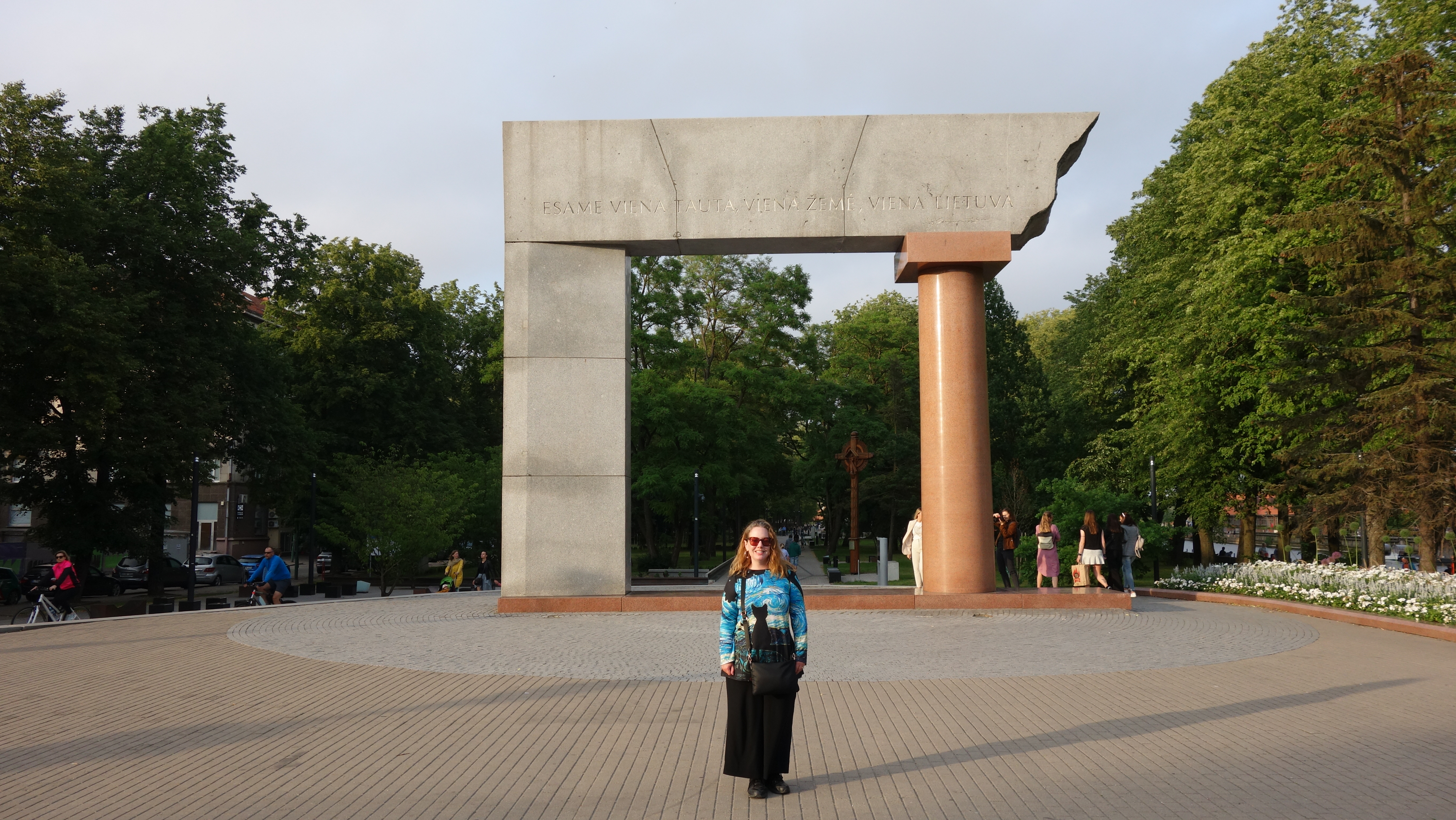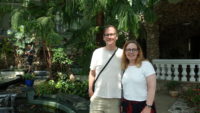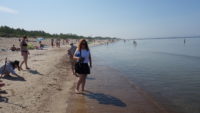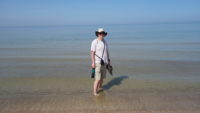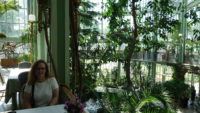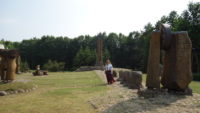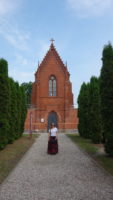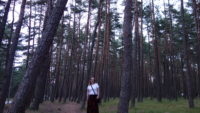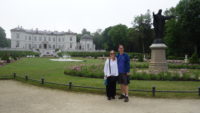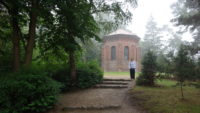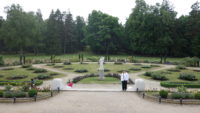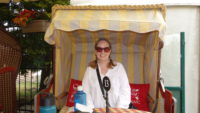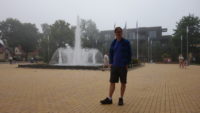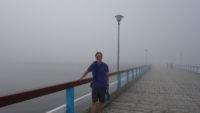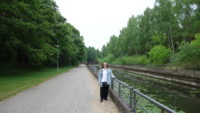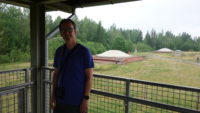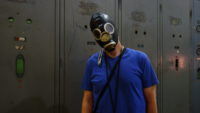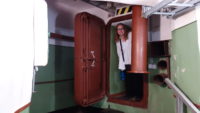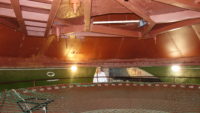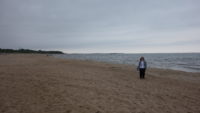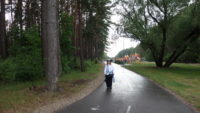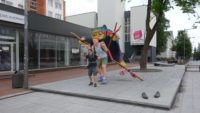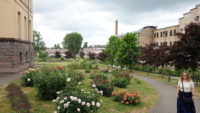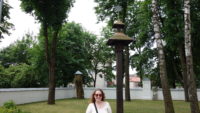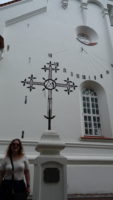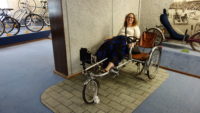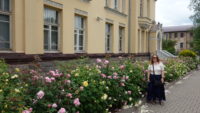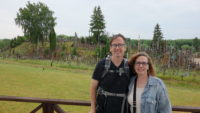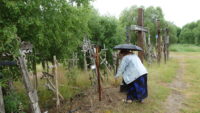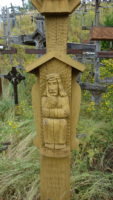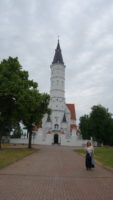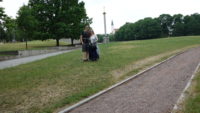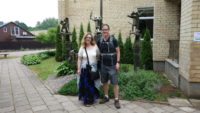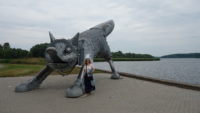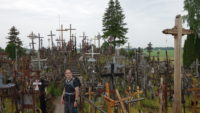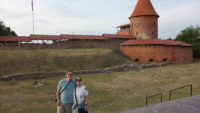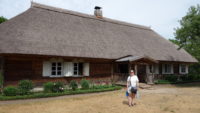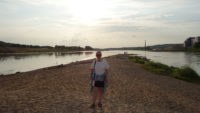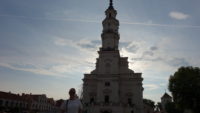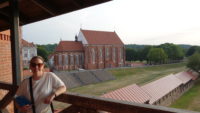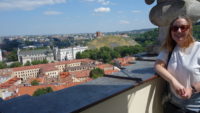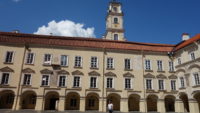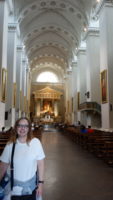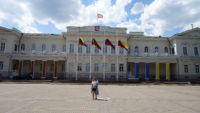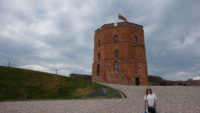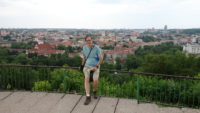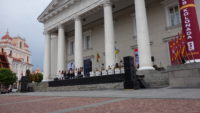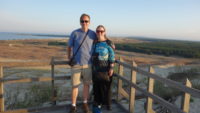 Growing up and for many years, I had thought that dunes were the sandy mounds you see at some beaches and in deserts. Then my mom and stepdad bought a house in Weko Dunes in western Michigan, and I learned that dunes can be densely covered in forests and don’t look sandy at all. Granted, if you dug down two inches, you’d hit sand, but I hadn’t realized that dunes could be covered in trees.
Growing up and for many years, I had thought that dunes were the sandy mounds you see at some beaches and in deserts. Then my mom and stepdad bought a house in Weko Dunes in western Michigan, and I learned that dunes can be densely covered in forests and don’t look sandy at all. Granted, if you dug down two inches, you’d hit sand, but I hadn’t realized that dunes could be covered in trees.
That is the case for much of the Curonian Spit. It’s a giant sandbar that stretches sixty miles out from the detached portion of Russia, Kaliningrad, with about half in Lithuania. It’s about two miles wide at the widest and has a tiny opening to the Baltic Sea in the north near Klaipeda. Most of the Spit we saw (the eastern side) is heavily forested with pines. At least some were planted to keep the dunes from shifting, since the drifting sand could cover villages. Back in the 1700s, Nida, where we are staying, had to move, as the old village was subsumed by sand. People later figured out that trees could help stop the drift.
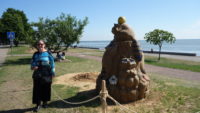 On one side of the Spit is the Baltic Sea, and on the other is the Curonian Lagoon. I kept seeing freshwater birds swimming on the lagoon, which I couldn’t figure out – the lagoon connected to the Baltic Sea in the north, so I figured it had to be salt water. I had Mer look it up, and it turns out that the southern end of the lagoon is fresh water. There is enough fresh water coming into the lagoon in the south from rivers, and the connection to the sea is so small, that the water stays salt-free (except in the north near the opening).
On one side of the Spit is the Baltic Sea, and on the other is the Curonian Lagoon. I kept seeing freshwater birds swimming on the lagoon, which I couldn’t figure out – the lagoon connected to the Baltic Sea in the north, so I figured it had to be salt water. I had Mer look it up, and it turns out that the southern end of the lagoon is fresh water. There is enough fresh water coming into the lagoon in the south from rivers, and the connection to the sea is so small, that the water stays salt-free (except in the north near the opening).
We crossed over on a car ferry from Klaipeda, with the trip taking about five minutes. We drove south on the Spit to the village of Juodkrantė. When we went to Sventoji the other day, we had thought it was going to be a small, cute, sleepy village. It wasn’t. Juodkrantė was, though. We got to the town and passed a few sculptures on the lagoon side of the road. I then realized that the complicated statues were made of sand. I pulled into the next parking lot, much to the amused exasperation of Meredith, who was in charge today. She humored me, and we went and looked at the sand sculptures, which were fantastic.
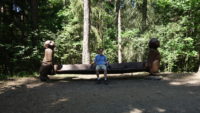 Mer wanted to tour in Juodkrantė anyway, so we left the car in the lot and walked along the lagoon through a (non-sand) sculpture park for about three quarters of a mile to the entrance to the Hill of Witches. That sounds more spooky than it really was. It should have been called “The Hill of Folk Tales,” but I wasn’t consulted. The Hill is a circular trail up a large, forested dune. Along the way are about eighty wooden sculptures depicting figures from various Lithuanian folk tales. There were many witches, but also ordinary people and animals and dragons. We tried to construct narratives for some of the sculptures. Most were pretty wild, and I’m sure we were wildly wrong. They were all fun to look at, and in a pretty place, so we had a good hike. One highlight was that there was a carved, adult-sized teeter-totter. Neither of us had been on a see-saw in decades, and we had a good time.
Mer wanted to tour in Juodkrantė anyway, so we left the car in the lot and walked along the lagoon through a (non-sand) sculpture park for about three quarters of a mile to the entrance to the Hill of Witches. That sounds more spooky than it really was. It should have been called “The Hill of Folk Tales,” but I wasn’t consulted. The Hill is a circular trail up a large, forested dune. Along the way are about eighty wooden sculptures depicting figures from various Lithuanian folk tales. There were many witches, but also ordinary people and animals and dragons. We tried to construct narratives for some of the sculptures. Most were pretty wild, and I’m sure we were wildly wrong. They were all fun to look at, and in a pretty place, so we had a good hike. One highlight was that there was a carved, adult-sized teeter-totter. Neither of us had been on a see-saw in decades, and we had a good time.
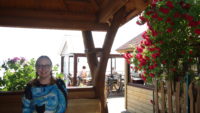 We came out of the woods about twenty feet from where we had gone in, and we headed back to the car. I was getting hungry, so Mer directed me to Preila, a really small village on the lagoon. We went to a restaurant which is now in my running for prettiest place to eat. We had a little wooden hut to sit in just for the two of us, and it looked out over the lagoon. There were roses all about, and the air smelled of them. The temperature was mild, and there was a gentle breeze. It was a wonderful stop.
We came out of the woods about twenty feet from where we had gone in, and we headed back to the car. I was getting hungry, so Mer directed me to Preila, a really small village on the lagoon. We went to a restaurant which is now in my running for prettiest place to eat. We had a little wooden hut to sit in just for the two of us, and it looked out over the lagoon. There were roses all about, and the air smelled of them. The temperature was mild, and there was a gentle breeze. It was a wonderful stop.
We then proceeded on south to the last Lithuanian village on the Spit, Nida. Nida is the largest Spit village, with 2400 people, but is still very quiet and walkable. And we did just that. After checking into the hotel (and petting the hotel kitty, Lancelot), we walked the town. Mer had picked up a tourist map and decided to go to the places marked on the map. She didn’t actually want to do any specific activity, like museums, but they were destinations to go to in the town.
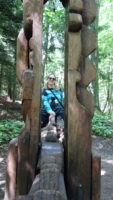 Some of the pre-supper highlights: we climbed from next to the lagoon up to a summer house built by the German author Thomas Mann. He was only able to use it for three summers before he had to leave Germany in 1933 for being critical of the Nazis. But it’s in a pretty place, and Mer loves literary connections.
Some of the pre-supper highlights: we climbed from next to the lagoon up to a summer house built by the German author Thomas Mann. He was only able to use it for three summers before he had to leave Germany in 1933 for being critical of the Nazis. But it’s in a pretty place, and Mer loves literary connections.
We swung by a shop and looked at some wares. I was taken by a pretty, small cello made of amber – about six inches tall. I asked to look at it, and the helpful saleswoman took it out and told me all about it and the 3200-euro price. We left without it. It was beautiful, though.
We checked out the local cemetery. Not only is it in a pretty location, up on the hill of the dune, but the headstones of the area are unique to the Spit. Many are made of wood, and the markers are carved – horse heads for men, and hearts and birds for women. There were also several wrought-iron crosses for more recent markers.
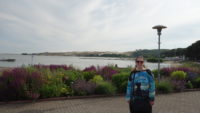 We regrouped at the hotel, and then went to explore the southern part of the town. It was a pleasant walk, as we stuck next to the lagoon. We found a restaurant that was next to a folk museum, and so we were treated to an a cappella group singing traditional songs that seemed to be mostly rounds (repeated phrases spaced apart a few seconds). If we hadn’t been in Lithuania, Mer and I both agreed we would have thought it was Native American singing.
We regrouped at the hotel, and then went to explore the southern part of the town. It was a pleasant walk, as we stuck next to the lagoon. We found a restaurant that was next to a folk museum, and so we were treated to an a cappella group singing traditional songs that seemed to be mostly rounds (repeated phrases spaced apart a few seconds). If we hadn’t been in Lithuania, Mer and I both agreed we would have thought it was Native American singing.
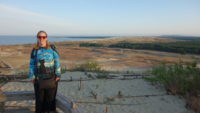 After supper, we had one last outing – we walked along the lagoon to take the stairs and boardwalk up the largest still-migrating dune in the area. It’s about 170 feet tall. We puffed up it, and the views from the top were worth it. Mer had hoped you could see both the lagoon and the Baltic Sea from the top, and you could. You could also see the cheerfully called “Valley of Death” below the dune, where only scrub grass grew, and you could see the curve of land that helped mark the border with Russia (about a mile away, as far as I could tell). The sun was about an hour from setting, but it was still pretty, with some puffy clouds reflecting the evening light. We lingered for about ten minutes, but couldn’t stay for sunset because we have a fairly early morning tomorrow with a four-hour drive back toward Kaunas.
After supper, we had one last outing – we walked along the lagoon to take the stairs and boardwalk up the largest still-migrating dune in the area. It’s about 170 feet tall. We puffed up it, and the views from the top were worth it. Mer had hoped you could see both the lagoon and the Baltic Sea from the top, and you could. You could also see the cheerfully called “Valley of Death” below the dune, where only scrub grass grew, and you could see the curve of land that helped mark the border with Russia (about a mile away, as far as I could tell). The sun was about an hour from setting, but it was still pretty, with some puffy clouds reflecting the evening light. We lingered for about ten minutes, but couldn’t stay for sunset because we have a fairly early morning tomorrow with a four-hour drive back toward Kaunas.
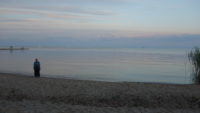 It was a fine stroll back to the hotel, as we stuck by the lagoon for most of the way. The evening had cooled off, and the lagoon waters kept changing color as the sun set. I’m very glad we got out to the Curonian Spit – it’s a special place. But, like the dunes, we too keep moving. On to Trakai Castle tomorrow.
It was a fine stroll back to the hotel, as we stuck by the lagoon for most of the way. The evening had cooled off, and the lagoon waters kept changing color as the sun set. I’m very glad we got out to the Curonian Spit – it’s a special place. But, like the dunes, we too keep moving. On to Trakai Castle tomorrow.
